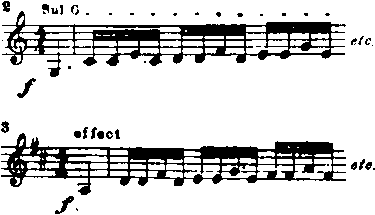Scordatura
The standard tuning of the violin in fifths; namely, G, D, A, E, is doubtless the best possible tuning that could be devised. It is now so thoroughly taken for granted that many fairly well-informed players are ignorant of the fact that in the early days of the art, abnormal and exceptional tunings were quite common and were often used with great ingenuity for special effects. The following tunings are all to be met with in the works of old violinists:

The tuning (a) is favorable to simplicity of fingering and great sonority in the key of A major. It was employed at least once each by Tartini and Castrucci in Italy, and very frequently by dance-fiddlers in Scotland. Some old Scotch reels demand it almost imperatively.
The tunings at (b) and (c) were occasionally employed by Biber. Who was Biber? Frankly speaking, we fear present-day musicians would find little satisfaction in attempting to resurrect his old compositions, yet he was quite a celebrity in his day. He flourished from 1638 to 1698, was conductor of music at the court of the Prince-Archbishop of Salzburg, and the Emperor Leopold presented him with a gold chain and a large sum of money, besides raising him to the rank of the nobility. Sic transit gloria mundi!
The tuning at (d) was employed once by Nardini; that at (e), which is intended to imitate the effect of the "Viola d'Amore," was used by Barbella and Campagnoli.
With the passing of years, the tuning of the violin seemed to become more rigidly standardized and these abnormal tunings less and less common, although they have never fallen quite into disuse.
Paganini employed several exceptional tunings, sometimes in quite a sensational manner. His Concerto in D major, which is still in the repertoire of many virtuosos, has the solo violin part in the key of D, but the orchestral accompaniment a semitone higher, in the key of E flat. For its performance, the violin strings are all tuned a semitone higher; viz.: A flat, E flat, B flat, F. When the Concerto was still in manuscript, and Paganini himself the only person who played it, he kept this fact a secret, even from the members of the orchestra, and it was supposed to be a concerto in E flat, which greatly increased the wonder at his performance, because, as every violinist knows, E flat is a much less favorable key for brilliant passages on the violin, and there are many effects possible in the key of D which would be out of the question in flat keys.
Spohr employed a similar device in his duets for violin and harp, but from an entirely different motive; the harp sounds much richer in keys of several flats, the violin more brilliant in sharps.
Several French violinists, including De Beriot, Mazas, Prume and Baillot, have used the scordatura effectively, but only on the G string. De Beriot in his Air Varie, No. 2, in D, tunes it up to A, thus giving it an almost trumpet-like resonance. He writes the part for this string as if in the key of C; the fingering thus remains the same and the unusual tuning of the string transposes it automatically into the key of D.

Composers are not uniform in their usage in this matter; some write the notes as they sound and leave the player to figure out the proper fingering, others (as in the above example) write the notes as fingered and make the violin a "transposing instrument."
In our own day Saint-Saens has used a most unique scordatura in his Danse Macabre--a symphonic poem in which Death is described as a fiddler, summoning the skeletons from their graves at midnight for a dance. The E string is tuned a semitone flat, giving a dull and uncanny effect.
Abnormal tuning of the other bowed string-instruments is uncommon. The writer knows of no example whatever on the viola; on the double bass the lowest string is occasionally tuned a tone lower so as to secure added compass downward, though at the expense of resonance. On the violoncello there are two classical examples: Bach, in his Fifth Violoncello Sonata requires the A string to be tuned to G, and Schumann, in the slow movement of his Piano Quartet, Op. 47, calls for a tuning of the C string down to B flat. This last, by the way, is done in the course of the movement, while the other players are playing, and, although a sufficiently long rest is allowed the 'cellist, is exceedingly awkward to manage. It is done for a good and legitimate reason, namely, to furnish a low B flat for an "organ-point," but one cannot help wishing that Schumann had thought of some other way out of the difficulty.
This article would not be complete without mentioning the interesting fact that certain scordatura effects seem to be well known to that now rapidly vanishing race, the old-fashioned country fiddler who plays by ear. In his youth, he once heard and committed to writing an old traditional tune, known as Snow-bird on the Ashpile;--

The proper rendering of this calls for the G and D strings to be tuned to A and E, respectively, exactly as in the example from Tartini and Castrucci. The three opening notes are executed with a sort of rough ricochet staccato.
About the Lesson
- Title: Scordatura
- Author: Edwin H. Pierce
- Source: The Etude January 1920 p. 60
- Download: PDF version of original article
